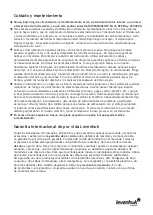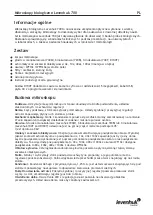
Operating principle and illumination
Image creation system:
objective (6), prism (7) and eyepiece (9). The
objective lens (6) magnifies a specimen (0), light rays pass through the prism
(7), refract at a 45° angle and create an image in the eyepiece. Total
magnification may be calculated by multiplying magnifications of the
eyepiece and the objective used.
Using the microscope
Getting started
Unpack the microscope and make sure all parts are available.
Move the stage to the lowermost position using the focusing knob and turn on the illumination or
adjust the reflector to evenly illuminate the specimen within the field of view.
Connect the microscope to A/C power using the A/C adapter.
Insert the eyepiece into the eyepiece tube.
Slowly adjust the illumination brightness, from dark to light. When you finish your observations,
always dim the illumination before unplugging the power cable.
If you need to change the light bulb, unplug your microscope first.
Illumination system:
lamp (1), collector lens (2), diaphragm (3) and
condenser (4). Light emitted from the lamp (1) passes through the collector
lens (2) and illuminates the diaphragm (3). Then, the light is focused by the
condenser (4). This illumination system is used for observations of a
specimen (0) in transmitted light. You can also use a different type of
illumination (e.g. a reflector) for observations in reflected light.
Focusing
Place a specimen on the stage and fix it with the holders.
Select the 4x objective rotating the revolving nosepiece.
Center the observed specimen in the field of view.
Rotate the focusing knob to slowly raise the stage until the objective is close to the specimen;
keep checking the distance between the objective and the object to avoid their contact.
CAUTION:
The objective should not touch the specimen, otherwise the objective or/and the
specimen might be damaged.
Look through the installed eyepiece and lower the stage slowly rotating the focusing knob until
you see the sharp image of the observed specimen.
Such adjustment protects the frontal lens from contacting the object when you use objectives
of other magnifications; though, slight refocusing might be required.
If the image is too bright, adjust the diaphragm disk until the passing light ray is reduced to a
comfortable brightness level. If the image is too dark, increase the light ray.
Selecting the objective
Start your observations with the lowest magnification objective (4x) and select a specimen
segment for detailed research. Then move the specimen to center the selected segment in the
field of view, to make sure it keeps centered when the objective is changed to a more powerful
one. Once the segment is selected, you should center its image in the microscope's field of view
as precisely as possible. Otherwise, the desired segment might fail to center in the field of view
of the higher power objective.
Now you can switch to a more powerful objective by rotating the revolving nosepiece. Adjust
the image focus, the iris diaphragm and the illumination brightness if required.
When using a 100x objective lens, you have to fill the space between the lens and the specimen
with immersion oil. There should be no air bubbles in the oil, as they might reduce the resulting
quality of the image. You must wipe the 100x objective clear after using it.






































